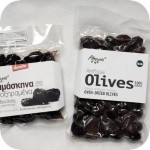
On the Internet you will find a lot of articles about the quality of oil and its health properties. This is a topic that has been very well developed by many researchers. Recently, however, Greek and American scientists have decided to devote more attention to olives themselves, ie the fruit of the Olea europe tree. The results of their research show that, depending on the method of processing used, olives retain different levels of valuable antioxidants.
Have you ever tried to eat olives straight from the tree? If so, you certainly remember her very bitter taste, which prevents eating raw fruit. The characteristic bitterness of fresh olives is due to the content of various phenolic compounds. For olives to be edible, one must partially get rid of this bitter taste by processing them.

Three types of olive processing are currently used in industrial production. Which one is used depends on the region of the world, cultivated varieties and the moment when the fruit was harvested from trees.
It stands out therefore:
In Greece, one more method is used to prepare overripe olives in dry salt, but it is used for local needs. These olives did not participate in the study, but we put information about this preparation into order. You can read about these olives in another article: Olives in salt from Palechory .
The names of the above methods are less related to the country of origin of the method, although they are obviously related to it, they currently symbolize the type of processing used.
In the Spanish and Californian style, in order to get rid of some of the bitter substances, several times the olive oil is dipped in a solution of sodium hydroxide (lye) and then in brine. This process takes up to several days and may affect the final color of the olives. Therefore, at this stage of production, ferrous gluconate (E579) is added to deepen the color of the fruit.
In the Greek style, sodium chloride (salt) is used, in a concentrated solution immersed in olives. This process is much longer than in the previous two methods and takes between 6 and 9 months. During its lifetime, fermentation processes occur that affect the overall taste of the olives. During this process, the color of the olives also changes, but is usually corrected by aerating the fruit for 2-3 days.
Each of these methods is designed to remove oleuropein , a bitter phenol compound. It is an antioxidant, an outstanding nutrient with a strong anti-inflammatory potential. It occurs only in olives and acts comprehensively on our organisms. Unfortunately, its large amount in olives makes them taste very bitter, making it unadulterated in raw form.
The task of the whole process is therefore to keep as many healthy Oleuropein as possible and simultaneously to bring the olives to such an extent that they become edible. Other key factors contributing to the formation of olive bittern are ligstroside and related hydrolysis products ( oleicin , oleocanthal , hydroxyterozoic glycoside , oligastril aglycon and oleuropein aglycon ), which are also involved in the prevention of age-related diseases.

As it turns out, the method of processing olives has a significant impact on the content of the above nutrients and the taste of the fruit. The scientists from the University of California and the University of Athens have just caught up with these differences. Olives processed with three methods described above, from three different producers were analyzed. Tandem mass spectrometry, an analytical technique allowing to determine the structure and chemical properties of the test compound was used for the tests.
The results of these analyzes showed that the olives processed in the Greek style were characterized by the highest concentration of all phenols (antioxidants), with the exception of oleocantal , the most of which was in green olives prepared in Spanish style.
Olives processed in the Californian style had the lowest level of most measured compounds. In the case of hydroxytyrosol , associated with cancer prevention and prevention of osteoporosis, its level in olives in the Greek and Spanish style was at a similar level, while in California style olives its concentration was significantly lower than in the other two.
According to the researchers, the liquors used at the stage of processing olives in the Spanish and Californian methods break down many valuable phenolic compounds that are irretrievably lost. Researchers hope that the results of their analysis will help processors find other, more natural ways of processing olives to maintain a high level of these antioxidants.
So how to use this knowledge in practice and consciously buy good olives? Read first of all the compositions on packaging. Olives processed with sodium hydroxide at a later stage have added deepening color of ferrous gluconate (E579), preservatives (eg potassium sorbate ). Often acidity regulators ( citric acid, lactic acid ), antioxidants ( ascorbic acid ) are also added, there are also thickeners (e.g., modified corn starch, also known as acetylated distarch adipate - E1422) and sometimes flavor enhancers ( monosodium glutamate - E621 ) . Theoretically, these are not harmful substances (when consumed in small quantities), however, their addition indicates the processing technology and, consequently, in the light of the described research on the content of beneficial substances in olives.
Meanwhile, if only the salt solution is used for processing the olives and water, you should only find brine in the composition, sometimes extra virgin olive oil or vinegar, herbs, sea salt. In this case, the old rule will prove that the shorter the composition the better.

In the photo above you can see examples of olives from Greece,
whose list of ingredients is kept to a minimum

The turn of August and September is the traditional period when a set of grapes for wine production is started in Crete. One of the most important decisions affecting the quality of the future drink is to determine the most favorable harvesting moment.

During our culinary experiments and during the preparation of our everyday meals, we try to reach for unique products from Crete or Greece as often as possible. Many of them permanently fit into our menu and systematically reach our shopping lists. For some time, dried plums and black olives from the Greek company Atrapos have joined the group of this type of products. At the outset, it is worth emphasizing that both products are virtually in the permanent offer of the online store kreta24.pl.

When browsing the stalls with local products in Crete, you will certainly find Malotira, the so-called. Moutain Tea. This popular plant known under the Latin name sideritis syriaca grows wild in the mountainous areas of Crete in the Lefka Ori massif, thanks to which it is devoid of pollution. Malotira is one of many species of gentile, which is popular in the Mediterranean, the Balkans and the Middle East. Sideritis syriaca is a variation occurring only on Crete, and the specific smell of this dried plant and the flavor of the infusion are irresistibly associated with this island.
Komentarze
komentarz z
Pyszne! Mam oliwki z Krety czarne i zielone.
komentarz z
W obu wersjach naszym zdaniem smakowite :)
komentarz z
Trochę zostaw przekonam się czy nie kłamiesz co do smaku.
komentarz z
W sierpniu kierunek ➡️ Kreta ☀️ Uwielbiamy oliwki więc na pewno będzie to nasz przysmak
komentarz z
Powtórka z botaniki, bardzo wartościowy artykuł
Wypełnij poniższy formularz aby dodać komentarz
lub kliknij w poniższy link aby skorzystać z możliwosci komentowania przez facebooka:
https://www.facebook.com/crete.poland/posts/10155336343442551